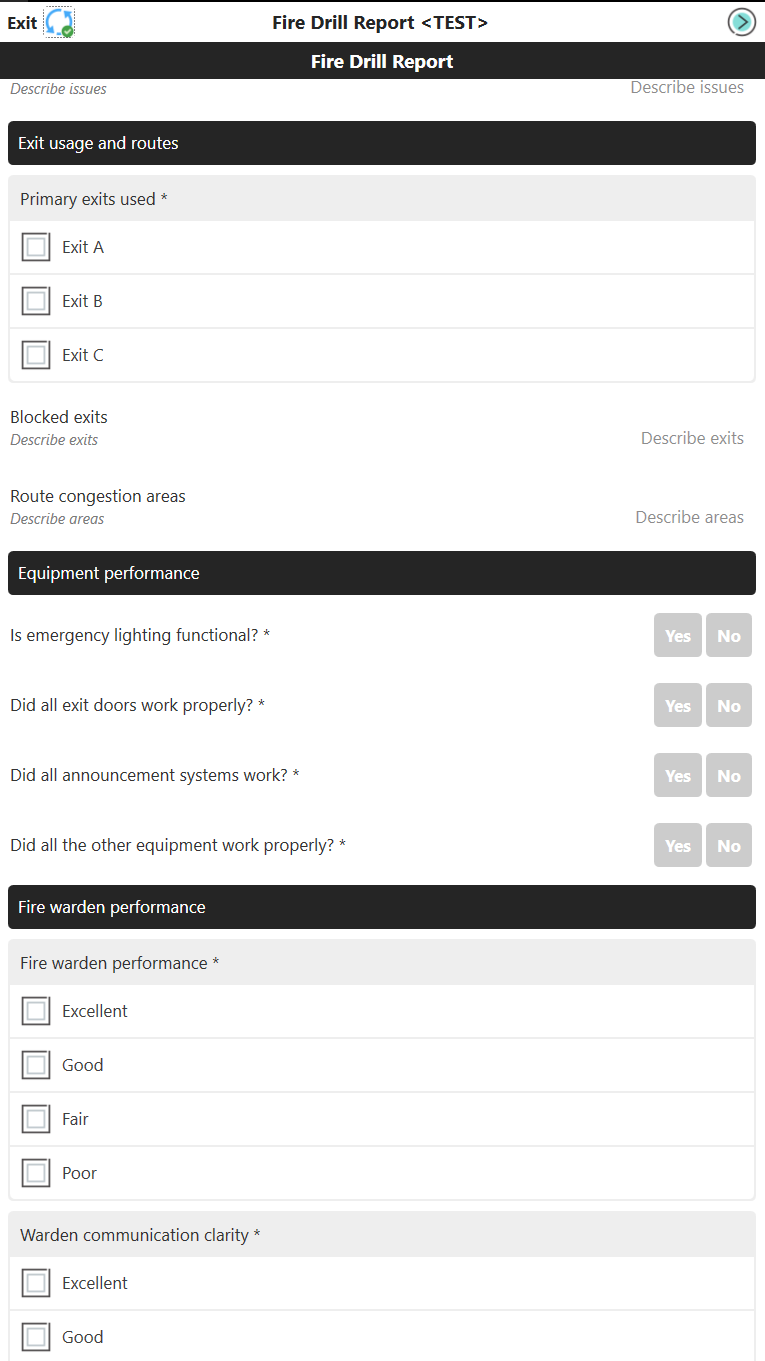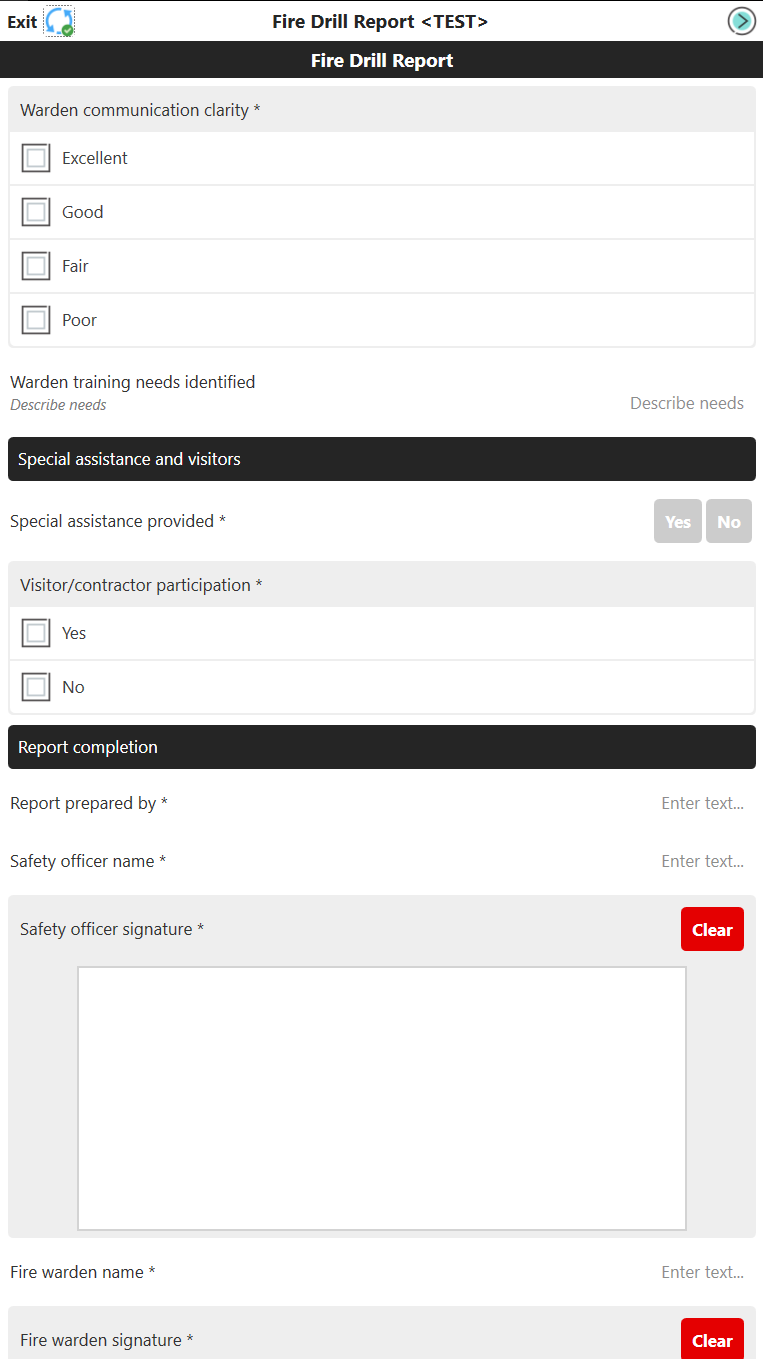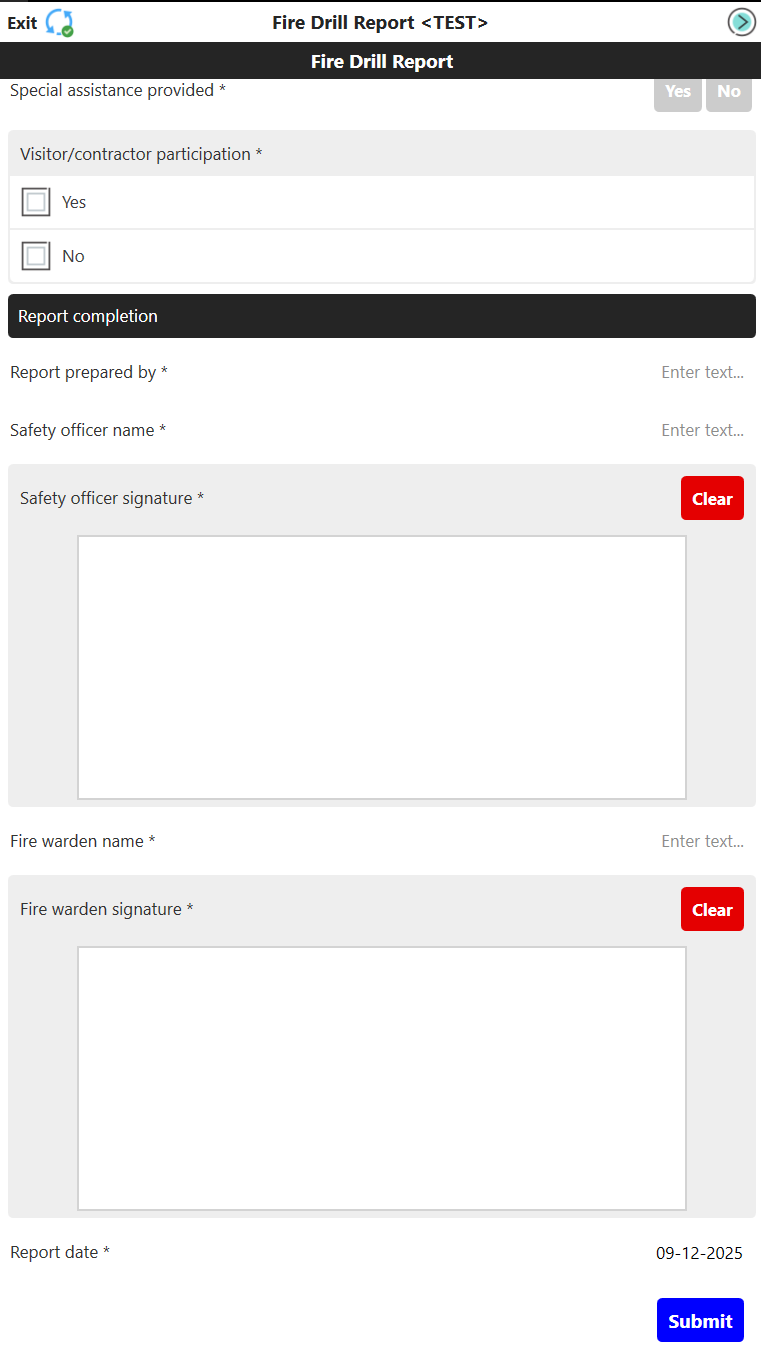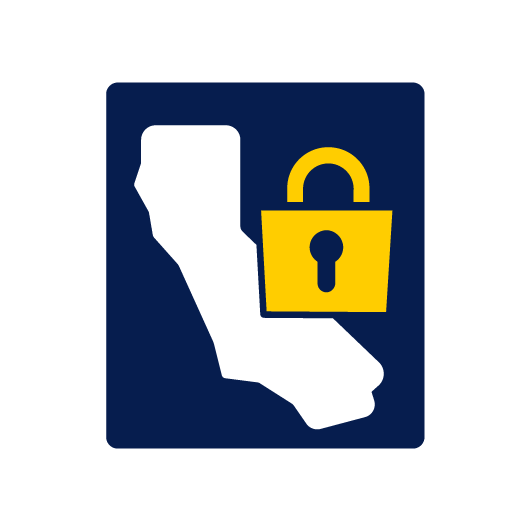Fire Drill Procedure, Checklist, and Report Form
A fire drill is a practice run to see if everyone can get out of your building quickly and safely when an alarm goes off. It tests whether your emergency plan actually works with real people doing real things — not just on paper.
Most workplaces are legally required to conduct regular fire drills, though the specifics vary by location and industry:
- OSHA requires that employees know how to respond to emergency alarms and that employers have an emergency action plan.
- Plus, local fire codes often mandate specific drill frequencies, usually quarterly or annually, for most businesses.
This article walks you through everything you need to know about running effective fire drills — alongside a functional fire drill checklist and report form to help streamline and record the process.
If you are just looking for a fire drill checklist, you can find it in our template database. Get access to hundreds of our templates by starting a free trial.
Objectives of a fire drill
The whole point behind fire drills is making sure your employees can get out fast and safely. You want everyone to know exactly where to go without having to think about it. That means testing your evacuation routes regularly and making sure your assembly points actually work for the number of people you've got.
At the same time, you're also checking that all your safety gear actually works when you need it. Alarms that don't sound, emergency lights that don't light, exit doors that are stuck — these are the kinds of problems you want to find during a drill, not during an emergency.
Furthermore, fire wardens and marshals need practice, too. Guiding a crowd of potentially panicked people takes confidence and clear thinking. Regular drills help them get comfortable with their role before they really need to step up.
Typical fire drill procedure
Running a fire drill isn't rocket science, but there's definitely a right way and a wrong way to do it. Here's how to run an effective fire drill.
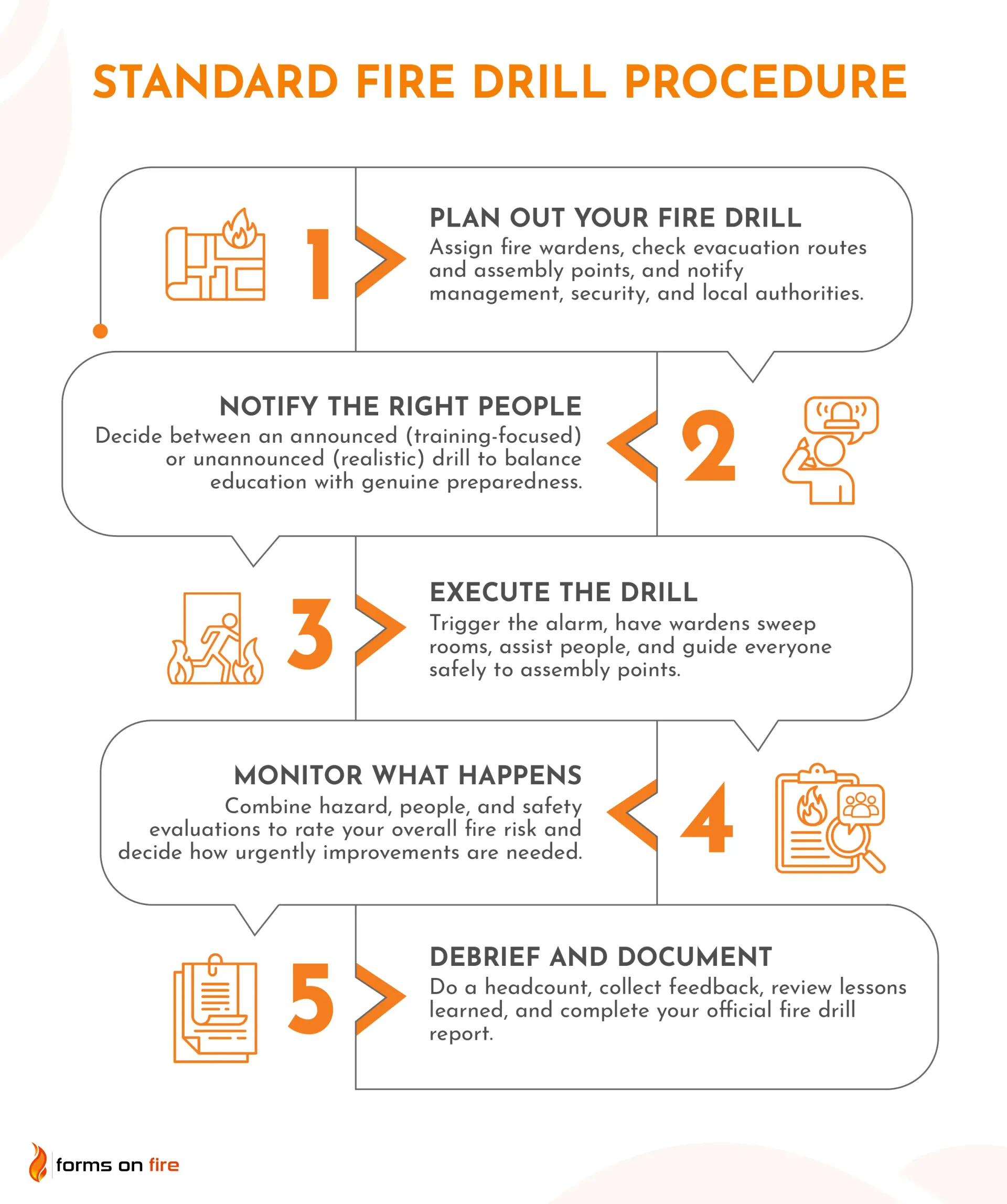
Step 1: Plan out your fire drill
Start by designating your fire wardens — pick people who won't disappear when things get hectic. Give each one a specific job, whether that's sweeping their floor, helping people with mobility issues, or doing a final headcount.
Walk those evacuation routes before the drill. Actually walk them. You'd be surprised how often you'll find a delivery blocking an exit or construction equipment in a stairwell. Check your assembly points, too; that nice spot in the parking lot might be great until it's pouring rain and you've got 200 people standing there.
Step 2: Notify the right people
Don't forget to inform the necessary personnel. Management, security, and your local fire department should all get a heads-up.
Here's where you decide if you're going for realism or education. Announced drills are easier on everyone; employees know it's coming, they participate properly, and you can actually teach them something. But they're also pretty artificial since real fires don't send calendar invites.
Unannounced drills show you what really happens when people think it might be real. You'll see who ignores the alarm, who tries to grab their purse, and who takes the elevator (yes, people actually do this). It's messier but more honest.
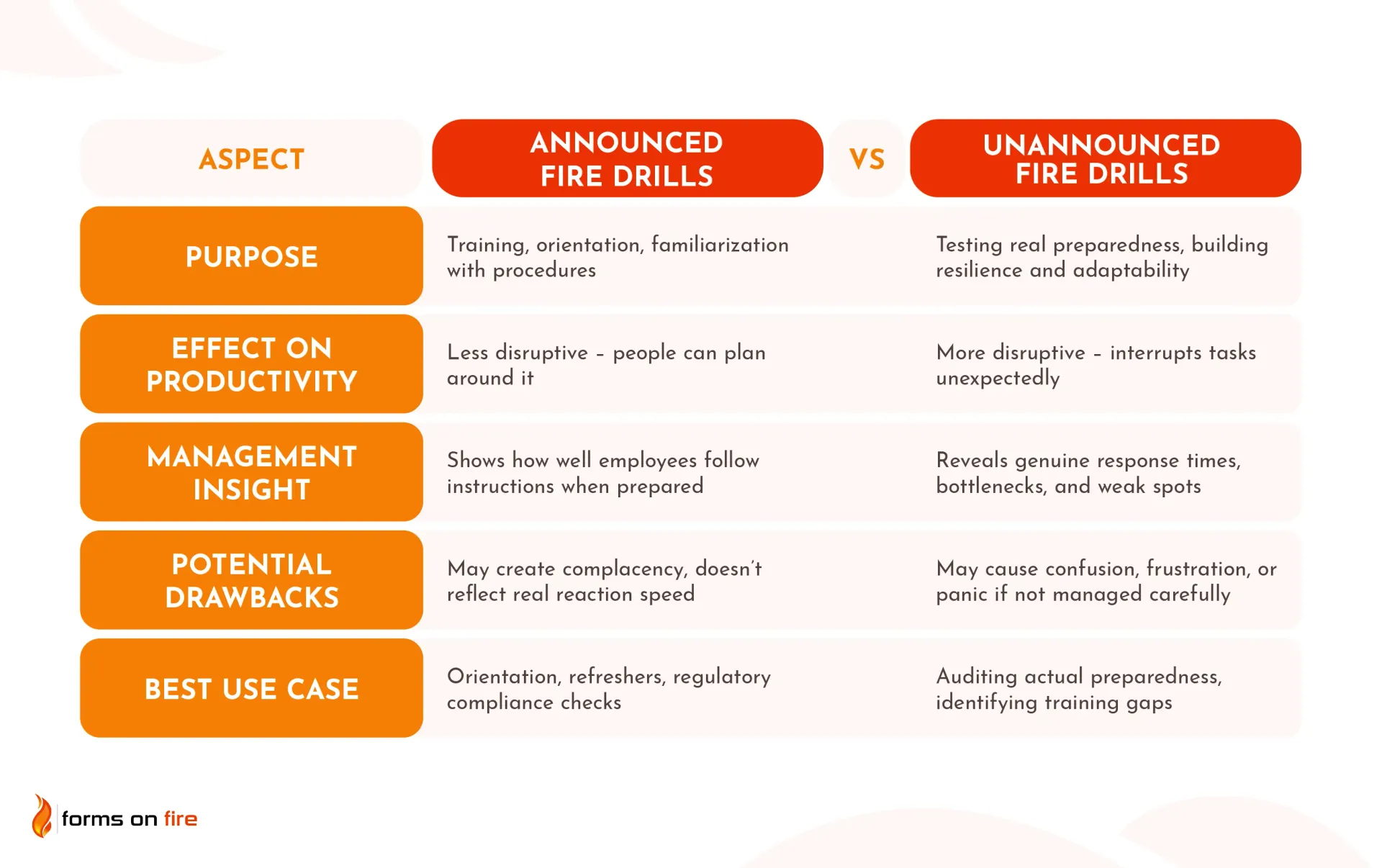
Step 3: Execute the drill
Now comes the real deal. Hit that alarm and watch what happens.
Your fire wardens earn their keep here. They've got several critical jobs to handle:
- Sweep every room, bathroom, and break room where someone might be hiding out.
- Check for people wearing headphones or taking phone calls who didn't hear the alarm.
- Assist anyone who needs extra help — mobility issues, visual impairments, or just having a rough day.
- Guide people to assembly points and keep them there (people can wander off or try to go back inside).
Everyone should be following those nice evacuation route signs you've posted everywhere, but don't count on it. Some will head for the elevator, others will go out the way they came in, and a few will just stand there looking confused.
Getting everyone to the assembly point sounds simple until you try it — people want to chat, grab their keys, or stand wherever's convenient for them.
Step 4: Monitor what happens
During the fire drill, someone needs to be watching and timing everything. How long did it actually take to get everyone out? Was it the three minutes you hoped for, or was it more like ten?
Pay attention to the human element:
- Who ignored the alarm?
- Who helped others?
- Who created bottlenecks by stopping to chat or panicking?
- Who looked genuinely confused about where to go?
These are the people you need to follow up with. Watch for the stuff that doesn't work:
- Did all the alarms actually sound?
- Were the exit signs visible?
- Were any doors locked or hard to open?
- Did your PA system work when the warden tried to give directions?
Write it all down because you'll forget the details later.
Step 5: Debrief and document
Make sure everyone is accounted for. Do a proper headcount at each assembly point and cross-check it against who was supposed to be in the building. This isn't busywork; in a real emergency, you need to know if someone's still trapped inside. If numbers don't add up, figure out why before you send the all-clear.
Now's your chance to get the good stuff — honest feedback while it's still fresh in everyone's minds. Talk to both fire wardens and to normal people who participated in the drill:
- Did they know where to go, or were they just following the crowd?
- What slowed them down or confused them?
- Did they see anything that could be improved?
With that, the only thing left is to submit your fire drill report form.
A workplace fire drill checklist to help with execution
Having a solid checklist keeps you on track when things get hectic. Here's your quick reference guide to make sure nothing important gets missed.
Before the fire drill:
- Assign roles: wardens, observers, and backups in case someone calls in sick.
- Check that the alarm system actually works and all exits open properly.
- Walk evacuation routes for obstacles or problems.
- Notify emergency services in advance, especially if your system auto-calls them.
- Brief your team on what to watch for and document.
During the drill:
- Keep observers positioned to spot problems and bottlenecks.
- Sound the alarm and start timing immediately.
- Ensure orderly evacuation: no running, no pushing.
- Verify accessibility assistance for people with disabilities.
- Confirm everyone reached the designated assembly points.
After the fire drill:
- Record the total evacuation time.
- Gather quick feedback from wardens and participants.
- List identified issues: blocked exits, slow response areas, instructions that caused confusion, etc.
- Document problems that need fixing before the next drill.
- Provide feedback and assign corrective actions with deadlines.
What to include in your fire drill report form
Your fire drill report is your proof that you're taking safety seriously and your roadmap for improvements. A good report captures what happened, what worked, and what needs fixing.
Recommended fields to include on a fire drill report form:
- Basic details: Date, time, weather conditions, and total occupancy. You'd be amazed at how the weather affects evacuation times.
- Evacuation time: Total time from alarm to final headcount. This is your key metric for measuring improvement.
- Alarm system performance: Did all alarms sound? Any areas where people couldn't hear them clearly?
- Exit usage: Which exits were used, and were there any that were blocked or problematic? Shows you traffic patterns and potential bottlenecks.
- Warden performance: Checks how well your fire wardens handled their assignments. Who needs more training?
- Attendance at assembly points: Final headcount and any missing persons. Critical for emergency accountability.
- Issues identified: A list of everything that went wrong, from stuck doors to confused employees.
- Names and signatures: One or more people responsible for conducting the fire drill and/or submitting the report. Usually, safety officers and wardens.
Essential fields cover the basics that any decent fire drill report should have: they're your legal requirements and safety fundamentals. Optional fields help you dig deeper into the details and can really improve your emergency preparedness, but you can still have a solid report without them.
Optional fields worth considering:
- Corrective actions required: Specific steps to fix problems, with deadlines and who's responsible.
- Employee compliance rate: Percentage of employees who actually participated versus those who ignored the drill.
- Special assistance provided: How well you handled people with mobility issues or other needs?
- Communication effectiveness: Did announcements work? Could wardens give clear directions?
- Visitor/contractor participation: Often forgotten but important if you have non-employees in the building.
- Equipment failures: Emergency lighting, door malfunctions, and communication system problems.
Here is an example of a fire drill report form built using Forms On Fire. You can click on the images to enlarge them.
Simplify fire drill logging with Forms On Fire
Encourage organizations to treat drills as learning opportunities, not just compliance exercises.
Use digital tools to streamline fire drill logging and corrective actions. No-code form builders like Forms On Fire enable safety officers to have a customized digital checklist and report form, allowing them to capture observations instantly and track fixes for identified issues. Later, those same reports can be quickly pulled up to prove compliance.
Start today with a digital solution. Try Forms On Fire for free to access ready-made fire drill templates and simplify your reporting process.
If you sign up, you’ll get access to our database that contains hundreds of other useful digital templates like:
- Monthly Fire Extinguisher Inspection Checklist
- Workplace Safety Checklist
- Visitor Log Template
- Incident Report Form Template
- Corrective Action Form
FAQs about fire drills
How often should fire drills be conducted?
Most businesses need to run fire drills at least annually (or more, per regulations). It depends on your local fire codes and industry: schools might need monthly drills, while some offices can get away with once a year. Check with your local fire marshal or building codes to be sure.
How long should a fire drill take?
A good evacuation should take 3-5 minutes from alarm to final headcount, depending on your building size and occupancy. If you're taking longer than 5 minutes regularly, you've got some bottlenecks to address.
What should be in a fire drill report?
Your fire drill report should include basic details like date and time, total evacuation time, any problems you spotted, and specific action items to fix issues. Don't forget to document warden performance, equipment failures, and whether everyone actually made it to the assembly points.
What are the OSHA standards for fire drills?
OSHA requires employers to have an emergency action plan and train employees on evacuation procedures, but they don't specify exact drill frequencies — that's usually covered by local fire codes. The key OSHA requirement is that workers must know how to respond to alarms and understand their role in emergency evacuations.


